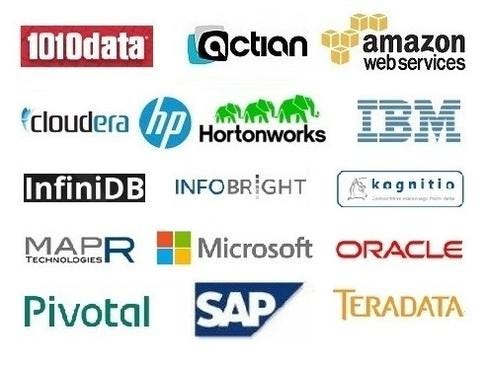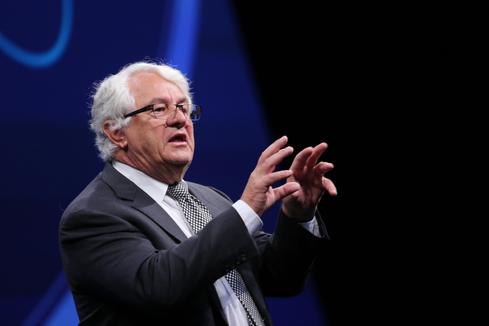SAP Chairman Hasso Plattner: Exclusive Q&ASAP Chairman Hasso Plattner: Exclusive Q&A
Hasso Plattner, SAP's Hana visionary, discusses customer ERP adoption, cloud deployment, and Oracle's alternative.


16 Top Big Data Analytics Platforms
16 Top Big Data Analytics Platforms (Click image for larger view and slideshow.)
SAP's Hana in-memory platform is gaining steam, but is there a big-company, small-company split? In this exclusive interview, Hasso Plattner, SAP's Hana visionary, discusses customer adoption and cloud deployment.
Everyone agrees that in-memory systems are faster and represent the future. The crux of SAP's promise of "radical simplification" is that its Hana in-memory platform can handle both analytical and transactional workloads, thereby eliminating "redundant" infrastructure and separate copies of data.
SAP introduced Business Suite on Hana (transactional support) last year, and at Sapphire 2014 SAP highlighted first-wave adopters. But are we seeing a split, with smaller customers leading on ERP deployments while larger customers are sticking with analytics?
[Want more on real-world deployments? Read 6 SAP Hana Customers Share Early Lessons.]
In this exclusive interview with information, conducted back stage after his SapphireNow keynote, SAP co-founder and Chairman Plattner discusses the embrace of Hana, the in-memory platform he dreamed up seven-and-a-half years ago. He also discusses SAP's cloud strategy and a wave of "Simple" offerings being introduced to streamline applications and make the most of Hana's performance.
information: We've seen quite a few customer references here at Sapphire -- Burberry, ConAgra, Colgate-Polmolive, John Deere, Mercedes AMG. Is there one that would be the best poster child for putting the SAP Business Suite on Hana? ConAgra, for example, seems like an analytical application.
Hasso Plattner: ConAgra built their modeling and simulation on the lowest level of granular data without changing the ERP system first. They thought that if they changed the ERP system first, they wouldn't get to the benefit of real-time modeling [soon enough]. They're going to work on the ERP system later, but other companies are doing it differently. Which company is the best example? It's tough to say because they're all in different stages of deployment.
IW: It seems like larger firms are starting with analytical deployments.
Plattner: That's because we were wimps and thought we'd go the easy way and do the read-only [analytical] applications first. My radical approach, if I may say so, scares people, but they're starting to see that they don't have to be scared.
John Deere asked me three years ago, "should we go big bang." I said, "I would start with the most rewarding application." They said, "that's predictive maintenance." They can save so much money with predictive maintenance. If we also revolutionize their financial system, it will do something for them, but it will not give them the financial impact they'll have with predictive maintenance, so they're doing that first and they start now to change their first manufacturing system.
Figure 2:  SAP Chairman Hasso Plattner delivering the keynote address at SapphireNow 2014
SAP Chairman Hasso Plattner delivering the keynote address at SapphireNow 2014
IW: Meanwhile, all the Business Suite-on-Hana examples here seem to be smaller companies, like Bangkok Airlines, Mercedes AMG, and Kaeser. Is it harder to get large companies to put ERP on Hana?
Plattner: Actually, the large companies are very close. They're not only monitoring this opportunity, they are preparing for it. All of the large customers I'm familiar with are going to [move to Hana]. If there is any hesitation or lack of urgency, it's at the smaller companies. The larger companies are excited, and they're strategically working with us and moving. Even the super-large companies are all doing something [on Hana], and they're all talking strategically.
IW: Do you think many companies are holding back to see what they can do with in-memory table capabilities coming in Oracle 12c or already available from Microsoft [in SQL Server 2014]?
Plattner: I assume that their massive salesforce is having an impact. If I put myself in the shoes of Oracle, I would try to tell a story to delay these decisions. That's not slowing us down. We are close to the maximum speed [of Hana adoption] we can support with our services and partners. Our biggest limitation is how many [technical] people can be educated on Hana. That's why we're moving to free Massive Open Online Courses, because thousands of people have to learn and understand what is different about Hana. I've been working on this for seven and a half years, so I underestimate how much you have to reset your brain to understand the possibilities.
IW: Does mixing the cloud-deployment decision with the Hana move complicate matters?
Plattner: No, it simplifies and accelerates the move. Even if it's only for the deployment phase, it's clearly the superior platform. If companies are hesitating and don't want to make the decision, cloud or on-premises, we suggest to them, "let's do the project on our computers in the cloud. Once the system is ready, we can discuss where to do the production deployment, whether that's cloud or on-premises."
IW: That's where the Hana Enterprise Cloud is different than other clouds in that it's a private, hosted cloud, not a multi-tenant service. Does that make larger customers more comfortable with cloud?
[Want more on real-world deployments? Read 6 SAP Hana Customers Share Early Lessons.]
Plattner: I don't understand why people are hung up on this multi-tenant thing. We do multi-tenancy for Ariba. Do you think multi-tenancy is less safe? Shouldn't Ariba be safe?
IW: Is that an argument to do everything in a multi-tenant environment?
Plattner: Multi-tenancy is good when you have many relatively small communities doing similar things. Ariba is one example. Talent management is one. Salesforce automation is one. Salesforce automation for a company with 10,000 salespeople is a [case for] a separate system. Any of the larger ERP system are dedicated -- that's what I call it instead of "hosted" -- because they have to be standard systems. That have to be much more standardized, otherwise we do not get economies of scale.
Multi-tenancy is a less-important part of the cloud business. The important part of the cloud business is to offer rental. If people think dedicated systems are safer, fine, it is a safer environment. We don't share hardware between an Exxon and a British Petroleum. The big change is that the software can be rented. In the early days of SAP, long before we became public, we had rental software. In the end you make more money.
The most important thing in the cloud is that the manufacturer of the applications can provide the service of the application at any time of the day from any location, permanently. That means we can permanently improve and update the service. This is huge. Our simplified systems enable us to add to or change the system constantly, not by replacing but by putting something in place in parallel.
Figure 1: SAP Chairman Hasso Plattner, right, and SAP Executive Board Member Bernd Leukert meet with press and analysts at Sapphire 2014.
IW: Simple Finance is the first "simplified system," but you've announced that many more will follow. How should we think about these simplified offerings, because they're not really "new" applications?
Plattner: It's a component -- a piece of the application that handles certain functionality. These components are linked together by the [Hana] platform. The next might be, say, 50 new Fiori apps for certain functionality. The customer can traverse between the current system and the new system, and when the users are ready, they can switch over. They don't have to switch over on a certain day determined by IT.
IW: Do customers have to worry about losing customizations from their current systems?
Plattner: We carry everything the customer has deployed on [SAP Business Suite] forward. Just looking at accounts receivables within SAP, we have 44 different layouts in our shared services center. Our users have defined them. We cannot ask customers to redo such customizations only because we want to move them forward to Simplified Finance. Their old transactions work on the simplified data model. That's the first transition we did. The second transition is that we've put in a new application and a new accounts receivable line-item display into the system that carry forward the customizations of existing applications. So when customers go to the new applications, they will still see their layouts and will not lose their customized views.
IW: And yet Simple Finance is described as introducing new user interfaces and stripping out old code. Doesn't that introduce change?
Plattner: This is something SAP handles and it's non-disruptive to the end user. If users cannot adapt to new user interfaces within two-and-a-half hours, then we're not doing it. Any new interfaces introduced have to be intuitive... Since the system is so much faster, the learning curve is faster. John Deere planned to have 14 work days for engineers to use their [Hana-based predictive maintenance] system. They cancelled the education after two days because the engineers said there's nothing more to learn; we know the system. Our brain does not work well when the partner we have a dialogue with is slower than we are. If something is extremely fast, you can learn to operate the system on the fly.
You can use distributed databases without putting your company's crown jewels at risk. Here's how. Also in the Data Scatter issue of information: A wild-card team member with a different skill set can help provide an outside perspective that might turn big data into business innovation. (Free registration required.)
About the Author
You May Also Like






